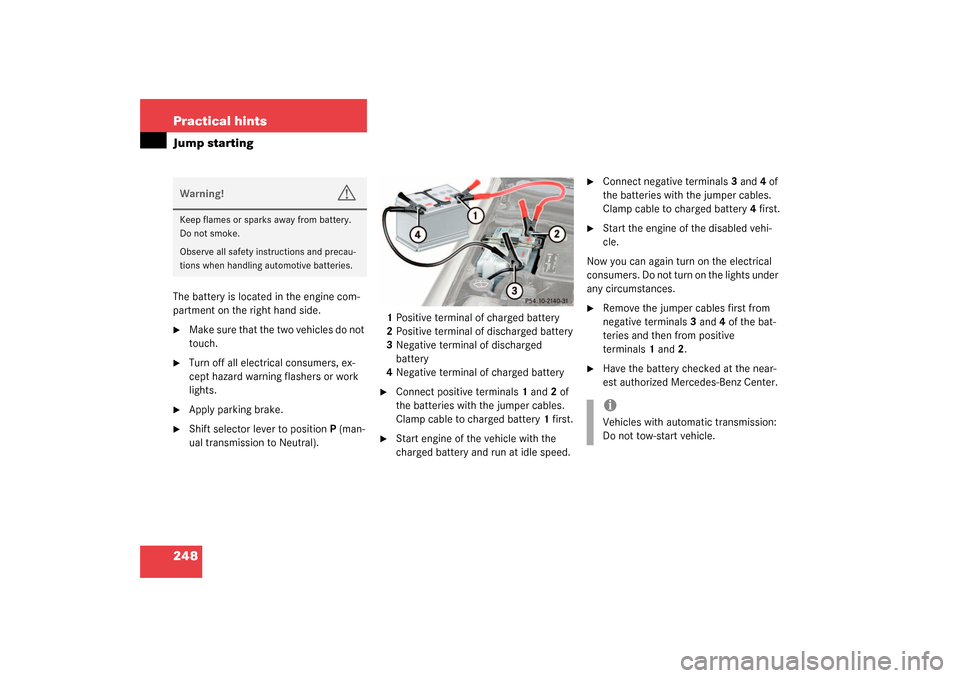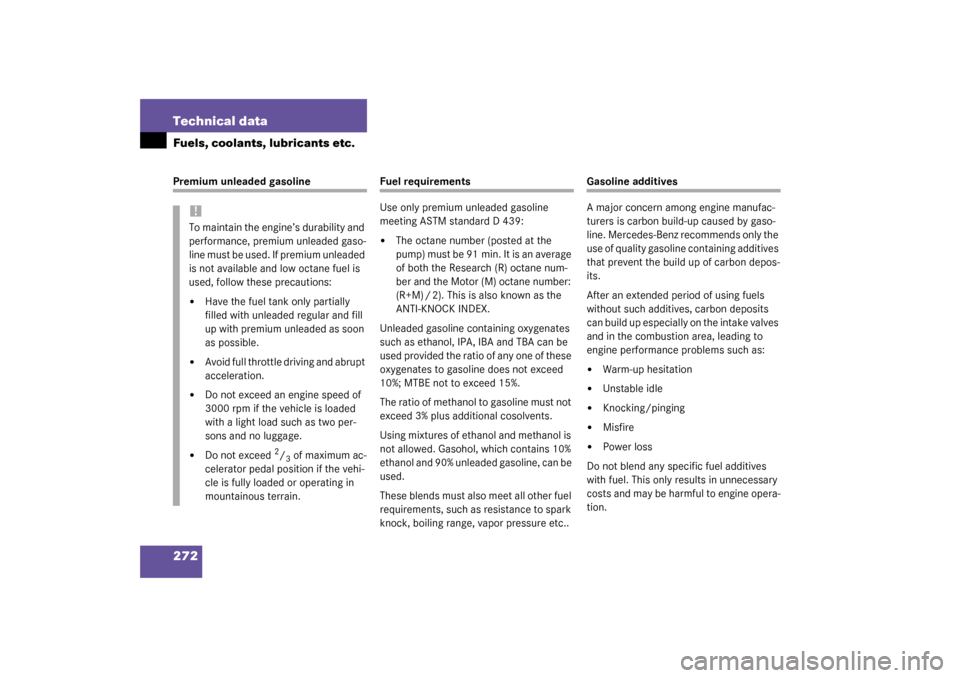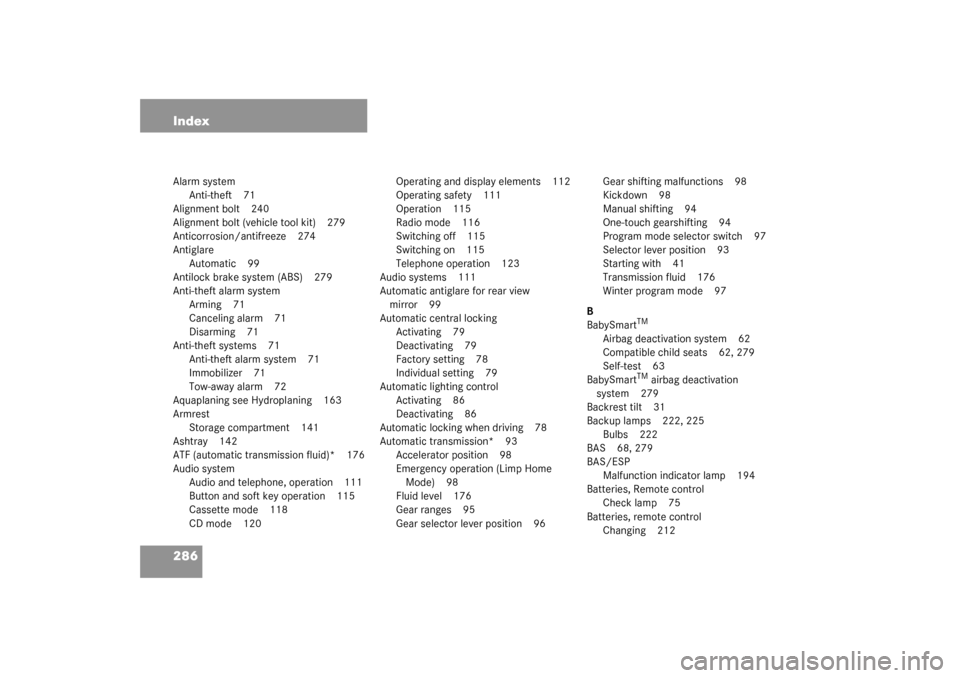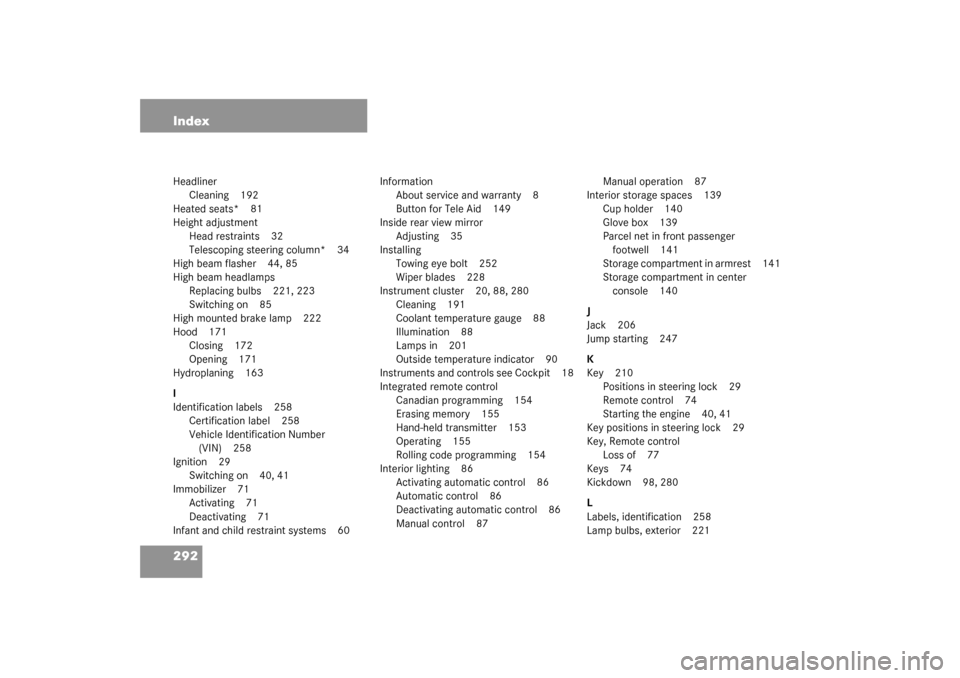Page 248 of 304

248 Practical hintsJump startingThe battery is located in the engine com-
partment on the right hand side.�
Make sure that the two vehicles do not
touch.
�
Turn off all electrical consumers, ex-
cept hazard warning flashers or work
lights.
�
Apply parking brake.
�
Shift selector lever to positionP (man-
ual transmission to Neutral).1Positive terminal of charged battery
2Positive terminal of discharged battery
3Negative terminal of discharged
battery
4Negative terminal of charged battery
�
Connect positive terminals1 and2 of
the batteries with the jumper cables.
Clamp cable to charged battery1 first.
�
Start engine of the vehicle with the
charged battery and run at idle speed.
�
Connect negative terminals3 and4 of
the batteries with the jumper cables.
Clamp cable to charged battery4 first.
�
Start the engine of the disabled vehi-
cle.
Now you can again turn on the electrical
consumers. Do not turn on the lights under
any circumstances.
�
Remove the jumper cables first from
negative terminals3 and4 of the bat-
teries and then from positive
terminals1 and2.
�
Have the battery checked at the near-
est authorized Mercedes-Benz Center.
Warning!
G
Keep flames or sparks away from battery.
Do not smoke.
Observe all safety instructions and precau-
tions when handling automotive batteries.
iVehicles with automatic transmission:
Do not tow-start vehicle.
Page 272 of 304

272 Technical dataFuels, coolants, lubricants etc.Premium unleaded gasoline
Fuel requirements
Use only premium unleaded gasoline
meeting ASTM standard D 439:�
The octane number (posted at the
pu mp ) m us t b e 91 mi n. It is an a ve ra ge
of both the Research (R) octane num-
ber and the Motor (M) octane number:
(R+M) / 2). This is also known as the
ANTI-KNOCK INDEX.
Unleaded gasoline containing oxygenates
such as ethanol, IPA, IBA and TBA can be
used provided the ratio of any one of these
oxygenates to gasoline does not exceed
10%; MTBE not to exceed 15%.
The ratio of methanol to gasoline must not
exceed 3% plus additional cosolvents.
Using mixtures of ethanol and methanol is
not allowed. Gasohol, which contains 10%
ethanol and 90% unleaded gasoline, can be
used.
These blends must also meet all other fuel
requirements, such as resistance to spark
knock, boiling range, vapor pressure etc..
Gasoline additives
A major concern among engine manufac-
turers is carbon build-up caused by gaso-
line. Mercedes-Benz recommends only the
use of quality gasoline containing additives
that prevent the build up of carbon depos-
its.
After an extended period of using fuels
without such additives, carbon deposits
can build up especially on the intake valves
and in the combustion area, leading to
engine performance problems such as:�
Warm-up hesitation
�
Unstable idle
�
Knocking/pinging
�
Misfire
�
Power loss
Do not blend any specific fuel additives
with fuel. This only results in unnecessary
costs and may be harmful to engine opera-
tion.
!To maintain the engine’s durability and
performance, premium unleaded gaso-
line must be used. If premium unleaded
is not available and low octane fuel is
used, follow these precautions:�
Have the fuel tank only partially
filled with unleaded regular and fill
up with premium unleaded as soon
as possible.
�
Avoid full throttle driving and abrupt
acceleration.
�
Do not exceed an engine speed of
3000 rpm if the vehicle is loaded
with a light load such as two per-
sons and no luggage.
�
Do not exceed
2/3of maximum ac-
celerator pedal position if the vehi-
cle is fully loaded or operating in
mountainous terrain.
Page 286 of 304

286 IndexAlarm system
Anti-theft 71
Alignment bolt 240
Alignment bolt (vehicle tool kit) 279
Anticorrosion/antifreeze 274
Antiglare
Automatic 99
Antilock brake system (ABS) 279
Anti-theft alarm system
Arming 71
Canceling alarm 71
Disarming 71
Anti-theft systems 71
Anti-theft alarm system 71
Immobilizer 71
Tow-away alarm 72
Aquaplaning see Hydroplaning 163
Armrest
Storage compartment 141
Ashtray 142
ATF (automatic transmission fluid)* 176
Audio system
Audio and telephone, operation 111
Button and soft key operation 115
Cassette mode 118
CD mode 120Operating and display elements 112
Operating safety 111
Operation 115
Radio mode 116
Switching off 115
Switching on 115
Telephone operation 123
Audio systems 111
Automatic antiglare for rear view
mirror 99
Automatic central locking
Activating 79
Deactivating 79
Factory setting 78
Individual setting 79
Automatic lighting control
Activating 86
Deactivating 86
Automatic locking when driving 78
Automatic transmission* 93
Accelerator position 98
Emergency operation (Limp Home
Mode) 98
Fluid level 176
Gear ranges 95
Gear selector lever position 96Gear shifting malfunctions 98
Kickdown 98
Manual shifting 94
One-touch gearshifting 94
Program mode selector switch 97
Selector lever position 93
Starting with 41
Transmission fluid 176
Winter program mode 97
B
BabySmart
TM
Airbag deactivation system 62
Compatible child seats 62, 279
Self-test 63
BabySmart
TM airbag deactivation
system 279
Backrest tilt 31
Backup lamps 222, 225
Bulbs 222
BAS 68, 279
BAS/ESP
Malfunction indicator lamp 194
Batteries, Remote control
Check lamp 75
Batteries, remote control
Changing 212
Page 292 of 304

292 IndexHeadliner
Cleaning 192
Heated seats* 81
Height adjustment
Head restraints 32
Telescoping steering column* 34
High beam flasher 44, 85
High beam headlamps
Replacing bulbs 221, 223
Switching on 85
High mounted brake lamp 222
Hood 171
Closing 172
Opening 171
Hydroplaning 163
I
Identification labels 258
Certification label 258
Vehicle Identification Number
(VIN) 258
Ignition 29
Switching on 40, 41
Immobilizer 71
Activating 71
Deactivating 71
Infant and child restraint systems 60Information
About service and warranty 8
Button for Tele Aid 149
Inside rear view mirror
Adjusting 35
Installing
Towing eye bolt 252
Wiper blades 228
Instrument cluster 20, 88, 280
Cleaning 191
Coolant temperature gauge 88
Illumination 88
Lamps in 201
Outside temperature indicator 90
Instruments and controls see Cockpit 18
Integrated remote control
Canadian programming 154
Erasing memory 155
Hand-held transmitter 153
Operating 155
Rolling code programming 154
Interior lighting 86
Activating automatic control 86
Automatic control 86
Deactivating automatic control 86
Manual control 87Manual operation 87
Interior storage spaces 139
Cup holder 140
Glove box 139
Parcel net in front passenger
footwell 141
Storage compartment in armrest 141
Storage compartment in center
console 140
J
Jack 206
Jump starting 247
K
Key 210
Positions in steering lock 29
Remote control 74
Starting the engine 40, 41
Key positions in steering lock 29
Key, Remote control
Loss of 77
Keys 74
Kickdown 98, 280
L
Labels, identification 258
Lamp bulbs, exterior 221